Tribal Masks
Although the ritual significance of masks has been diminished by
Western influence and civil unrest, they are still used for special occasions.
Western influence and civil unrest, they are still used for special occasions.
Mblo Mask
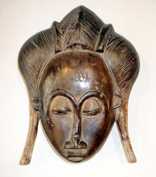
Baule Tribe - Ivory Coast
Baule masks correspond to several types of dances: the gba gba, the bonu amuen, the mblo and the goli. They never represent the ancestors and are always worn by men. The gba gba is used at the funerals of women during the harvest season. It celebrates beauty and age, hence its refined features. The double mask represents the marriage of the sun and the moon or twins, whose birth is always a good sign. The bonu amuen protects the village from external threats; it obliges the woman to a certain discipline; and it appears at the commemorations of death of notables. When they intervene in the life of the community, they take the shape of a wooden helmet that represents a buffalo or antelope and which is worn with a raffia costume and metal ankle bracelets; the muzzle has teeth, which incarnate the fierce animal that is to defend the group.
Mblo is the name of a performance category that uses face masks in skits and solo dances. Mblo masks, used in entertainment dances are one of the oldest of Baule art forms. These refined human face masks are usually portraits of particular known individuals. Mblo masks embody the core Baule sculpture style manifested in figures and decorated objects – spoons, combs, pulleys and the like. Lustrous curving surfaces, suggesting clean, healthy, well-fed skin, are set off by delicately textured zones representing coiffures, scarifications, and other ornaments. The idealized faces are introspective, with the high foreheads and the large downcast eyes. Ornaments above the face – birds, combs, horns, faces, and other decorative motifs – are chosen for their beauty, and have no iconographic significance. Fine scarifications and coiffures denote personal beauty, refinement and a desire to give pleasure to others.
Goli is the day-long spectacle that normally involves the whole village and includes the appearance of four pairs of masks, music played on special instruments, and, ideally, the jojoyous consumption of a great deal of palm wine. Goli can be performed both as an entertainment and for the funeral of important men. The very characteristic, round-shaped “lunar” goli is surmounted by two horns. It was borrowed from the Wan for a celebration adopted by the Baule after 1900. Celebrating peace and joy, they would sing, dance, and drink palm wine. In the procession, the goli preceded the four groups of dancers, representing young adolescents. The goli would be used on the occasion of the new harvest, the visit of dignitaries, or at the funerals of notables. Boxes for the mouse oracle (in which sticks are disturbed by a live mouse, to give the augury) are unique to the Baule, whose carvers also produce heddle pulleys, combs, hairpins, and gong mallets.
Baule masks correspond to several types of dances: the gba gba, the bonu amuen, the mblo and the goli. They never represent the ancestors and are always worn by men. The gba gba is used at the funerals of women during the harvest season. It celebrates beauty and age, hence its refined features. The double mask represents the marriage of the sun and the moon or twins, whose birth is always a good sign. The bonu amuen protects the village from external threats; it obliges the woman to a certain discipline; and it appears at the commemorations of death of notables. When they intervene in the life of the community, they take the shape of a wooden helmet that represents a buffalo or antelope and which is worn with a raffia costume and metal ankle bracelets; the muzzle has teeth, which incarnate the fierce animal that is to defend the group.
Mblo is the name of a performance category that uses face masks in skits and solo dances. Mblo masks, used in entertainment dances are one of the oldest of Baule art forms. These refined human face masks are usually portraits of particular known individuals. Mblo masks embody the core Baule sculpture style manifested in figures and decorated objects – spoons, combs, pulleys and the like. Lustrous curving surfaces, suggesting clean, healthy, well-fed skin, are set off by delicately textured zones representing coiffures, scarifications, and other ornaments. The idealized faces are introspective, with the high foreheads and the large downcast eyes. Ornaments above the face – birds, combs, horns, faces, and other decorative motifs – are chosen for their beauty, and have no iconographic significance. Fine scarifications and coiffures denote personal beauty, refinement and a desire to give pleasure to others.
Goli is the day-long spectacle that normally involves the whole village and includes the appearance of four pairs of masks, music played on special instruments, and, ideally, the jojoyous consumption of a great deal of palm wine. Goli can be performed both as an entertainment and for the funeral of important men. The very characteristic, round-shaped “lunar” goli is surmounted by two horns. It was borrowed from the Wan for a celebration adopted by the Baule after 1900. Celebrating peace and joy, they would sing, dance, and drink palm wine. In the procession, the goli preceded the four groups of dancers, representing young adolescents. The goli would be used on the occasion of the new harvest, the visit of dignitaries, or at the funerals of notables. Boxes for the mouse oracle (in which sticks are disturbed by a live mouse, to give the augury) are unique to the Baule, whose carvers also produce heddle pulleys, combs, hairpins, and gong mallets.
Bedu Plank Mask

Nafana Tribe - Ivory Coast
The Bedu mask is used to keep negative and harmful spirits away from the community. The dancer would tie the mask to his head and cover the rest of his body with raffia, making him completely disguised and unrecognizable. These masks are danced by athletic young men with amazing agility and grace. They usually appear in male and female pairs at funeral rites and during month-long harvest festivals (zaurau). The masks keep disaster, illness, and infertility at bay and increase the communitys sense of well-being.
Bedu generally appears once a year for between a week and a month, at the New Year festivities. These celebrate the renewal of the natural and the social order. Bedu embodies this transition because it is itself seen as a product of transfer. The mask is seen as the reproduction ("domestication") of the Bedu wild animal that lives in the bush. Sculpting transforms Bedu into a domesticated animal while painting Bedu invests it with authority.
At the New Year feast Bedu appears in two types of performances; Zorogo which parody and question the certainties of everyday life and classic Bedu performances which dramatise and reaffirm the social order. Throughout these performances the different groups make Bedu into an ally, an object of mockery or a divine creature. By incorporating these different identities Bedu emerges as an arbitrator between men and women, a cultural ambassador for the village and an advocate of consideration for children.
The Bedu mask is used to keep negative and harmful spirits away from the community. The dancer would tie the mask to his head and cover the rest of his body with raffia, making him completely disguised and unrecognizable. These masks are danced by athletic young men with amazing agility and grace. They usually appear in male and female pairs at funeral rites and during month-long harvest festivals (zaurau). The masks keep disaster, illness, and infertility at bay and increase the communitys sense of well-being.
Bedu generally appears once a year for between a week and a month, at the New Year festivities. These celebrate the renewal of the natural and the social order. Bedu embodies this transition because it is itself seen as a product of transfer. The mask is seen as the reproduction ("domestication") of the Bedu wild animal that lives in the bush. Sculpting transforms Bedu into a domesticated animal while painting Bedu invests it with authority.
At the New Year feast Bedu appears in two types of performances; Zorogo which parody and question the certainties of everyday life and classic Bedu performances which dramatise and reaffirm the social order. Throughout these performances the different groups make Bedu into an ally, an object of mockery or a divine creature. By incorporating these different identities Bedu emerges as an arbitrator between men and women, a cultural ambassador for the village and an advocate of consideration for children.
Butterfly Mask

Bobo Tribe - Burkina Faso
These masks are from the Bobo Tribe in Burkina Faso. They are worn in front of the face, attached with a thick rope which the dancer holds in his mouth. It can be decorated with concentric circles and or blackened geometrical markings and regularly feature a checkerboard backing. This mask represents a butterfly and is used to invoke the deity Do. This mask would be worn in ceremonies asking for rain and for fertility of the fields at planting time and after the harvest. Dancers would mimic the motion of the butterfly, which it is said that immediately after the first rains, swarms of butterflies appear. This dance is made in hopes that the gods will cause rain to fall on the newly planted field.
These masks are from the Bobo Tribe in Burkina Faso. They are worn in front of the face, attached with a thick rope which the dancer holds in his mouth. It can be decorated with concentric circles and or blackened geometrical markings and regularly feature a checkerboard backing. This mask represents a butterfly and is used to invoke the deity Do. This mask would be worn in ceremonies asking for rain and for fertility of the fields at planting time and after the harvest. Dancers would mimic the motion of the butterfly, which it is said that immediately after the first rains, swarms of butterflies appear. This dance is made in hopes that the gods will cause rain to fall on the newly planted field.
Chi Wara
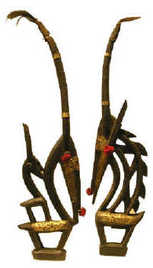
Bamana Tribe - Mali
At the beginning of the world, a being that was both animal and man (in some accounts half-man-half-antelope, a child of Mousso Koroni and of a snake, taught the people, with the aid of hist staff and his claws, how to change the thorny bush into millet fields. (Some accounts have Chi wara coming down from the sky.) The Bamana who followed his example became happy and prosperous. But the abundance of good things caused them to be careless of the Earth and forgetful of the tributes owed to the one who had brought the knowledge of agricultural techniques. Tyiwara (different spelling for Chi wara) reacted to this ingratitude by burying himself deep in the earth and waiting for men to redeem themselves and render to him the homage he deserved. Thereupon they sculpted antelope effigies (sogoni kun) and took them to fields when the millet was being hoed in order to honor the memory of the Bamana benefactor.
To this day, the Bamana's link with the earth is revealed in impressive ceremonies and dances, for which highly stylized antelope or antelope heads are carved and worn. The headresses may be worn only by circumcised youths, who are of the age group called "soli." The age groups are combined into larger units, flan ton or flan kuru. These combine into the larger field groups, the chi wara, and come forward every year when field work begins or when a new piece of land is cleared. While the young men of the society stand in rows breaking up the earth with hoes, spurred on by the rhythm of the drums and the singing of the women. The dancers, which are almost always in pairs, wear the antelope headdress, the Chi wara, and oversee the proper progress of the work.
The pair of dancers wear a long raffia cloak, a different color, frequently covering the face, and lean on staves; the Chi wara is secured to an inverted basket and tied to the head. Their dance (nearly extinct in some Bamana cultures due to Muslim influence) imitates the high, impulsive leaps of the frisking antelopes--imitating the working or farming (chi) wild animal (wara) who taught mankind how to cultivate the earth. During the performance, each mask has a special female partner who dances behind the masquerader, fanning the air to disseminate the spirit's aura. Not only is the Chi wara a fertility ritual to invoke fertile crops, but may alo appear in agricultural matches or centests between neighboring villages. Drumming, singing, dancing, costumes and headresses combine to send a message about the importance of agriculture, the virtues it demands of farmers, and the relation of the Bamana to the cosmos. The dances are now performed alrgely in the secular sense, singing the praises of the Chi wara.
At the beginning of the world, a being that was both animal and man (in some accounts half-man-half-antelope, a child of Mousso Koroni and of a snake, taught the people, with the aid of hist staff and his claws, how to change the thorny bush into millet fields. (Some accounts have Chi wara coming down from the sky.) The Bamana who followed his example became happy and prosperous. But the abundance of good things caused them to be careless of the Earth and forgetful of the tributes owed to the one who had brought the knowledge of agricultural techniques. Tyiwara (different spelling for Chi wara) reacted to this ingratitude by burying himself deep in the earth and waiting for men to redeem themselves and render to him the homage he deserved. Thereupon they sculpted antelope effigies (sogoni kun) and took them to fields when the millet was being hoed in order to honor the memory of the Bamana benefactor.
To this day, the Bamana's link with the earth is revealed in impressive ceremonies and dances, for which highly stylized antelope or antelope heads are carved and worn. The headresses may be worn only by circumcised youths, who are of the age group called "soli." The age groups are combined into larger units, flan ton or flan kuru. These combine into the larger field groups, the chi wara, and come forward every year when field work begins or when a new piece of land is cleared. While the young men of the society stand in rows breaking up the earth with hoes, spurred on by the rhythm of the drums and the singing of the women. The dancers, which are almost always in pairs, wear the antelope headdress, the Chi wara, and oversee the proper progress of the work.
The pair of dancers wear a long raffia cloak, a different color, frequently covering the face, and lean on staves; the Chi wara is secured to an inverted basket and tied to the head. Their dance (nearly extinct in some Bamana cultures due to Muslim influence) imitates the high, impulsive leaps of the frisking antelopes--imitating the working or farming (chi) wild animal (wara) who taught mankind how to cultivate the earth. During the performance, each mask has a special female partner who dances behind the masquerader, fanning the air to disseminate the spirit's aura. Not only is the Chi wara a fertility ritual to invoke fertile crops, but may alo appear in agricultural matches or centests between neighboring villages. Drumming, singing, dancing, costumes and headresses combine to send a message about the importance of agriculture, the virtues it demands of farmers, and the relation of the Bamana to the cosmos. The dances are now performed alrgely in the secular sense, singing the praises of the Chi wara.
Chokwe Tribe
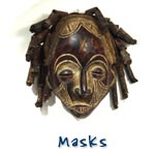
Chokwe Tribe - DRC
The Chokwe are made up of four sub-tribes, and live in Angola and the Congo, formerly Zaire. This Mwano Pwo mask represents a young woman freshly emerged from the initiation schools in the bush and ready for marriage. They were used in conjunction with the Chikungu, the male counterparts during initiation ceremonies and other important occasions to bring fertility and prosperity to the village. Most share the depiction of facial scarification patterns, filed teeth, fanciful and inventive hair styles, tear motifs and cruciform markings on the forehead. Often there is a reddish color from repeated rubbing of camwood offerings.
The Chokwe are made up of four sub-tribes, and live in Angola and the Congo, formerly Zaire. This Mwano Pwo mask represents a young woman freshly emerged from the initiation schools in the bush and ready for marriage. They were used in conjunction with the Chikungu, the male counterparts during initiation ceremonies and other important occasions to bring fertility and prosperity to the village. Most share the depiction of facial scarification patterns, filed teeth, fanciful and inventive hair styles, tear motifs and cruciform markings on the forehead. Often there is a reddish color from repeated rubbing of camwood offerings.
Circumcision Mask
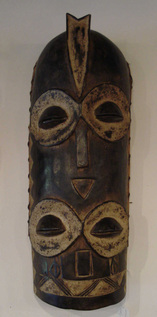
Bemba Tribe - DRC
The Bemba form a small group of 60 to 70 thousand people. They are of the rare eastern tribes living in the area around the northern shore of Lake Tanganyika, northeast of Zambia in the Demcratic Republic of the Congo. It is a traditionally restless area characterized by the migration of peoples. Warriors and hunters practice slash-and-burn agriculture; a social, ritual, and economic value is connected to the hunt. The Bemba are culturally eclectic, accepting influences from many directions in an area with complex historical relationships. This highly stylized mask represents the face of a spirit of nature with typical enlarged orbits of eyes. Such masks were used in circumcision camps for puberty rites or butende. It was worn with voluminous costumes made of banana leaves.
The Bemba form a small group of 60 to 70 thousand people. They are of the rare eastern tribes living in the area around the northern shore of Lake Tanganyika, northeast of Zambia in the Demcratic Republic of the Congo. It is a traditionally restless area characterized by the migration of peoples. Warriors and hunters practice slash-and-burn agriculture; a social, ritual, and economic value is connected to the hunt. The Bemba are culturally eclectic, accepting influences from many directions in an area with complex historical relationships. This highly stylized mask represents the face of a spirit of nature with typical enlarged orbits of eyes. Such masks were used in circumcision camps for puberty rites or butende. It was worn with voluminous costumes made of banana leaves.
Fang Tribe

Fang Tribe - Gabon
The Fang Tribe are famous for the great refinement of their masks, which display an austere simplicity of form. They are mainly used in the enforcement of law. The use of black to highlight the fine features is typical. The passport masks were used to show which tribe they belonged to. The smaller ones were carried in their pocket and the larger ones were put outside their home.
The Fang Tribe are famous for the great refinement of their masks, which display an austere simplicity of form. They are mainly used in the enforcement of law. The use of black to highlight the fine features is typical. The passport masks were used to show which tribe they belonged to. The smaller ones were carried in their pocket and the larger ones were put outside their home.
Guru Tribe
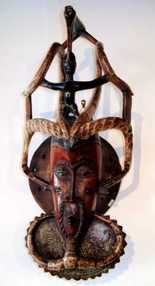
Guru Tribe - Ivory Coast
The Guro tribe was originally known as the "Kweni", but during 1906 - 1912 they were brutally colonized by invading French colonials. The dominant Baule people of the region subsequently named them the Guro tribe. The Guro peoples are governed and regulated by a council of elders, and each main family has representation on the council.
Guro mask represents the spirit of Gu, the wife of Zamble a supernatural being. Gu is often depicted as elegant, graceful, serene and beautiful. The Guro are well-known for their highly-decorated and colorful masks, which often combine human features with those of animals. They also have masks that are more simple and can be less colorful, and feature animal or human faces, without combining them.
The numerous masks of the Guro have some characteristics which make them quite easy to identify, although some of the more refined and subtle ones can be confused with their neighbors the Baule and Yaure. Important characteristics of note, found in Guro art besides the skillful combination of human and animal forms, are almond shaped eyes, rounded foreheads, finely sculptured nose and mouth with small but sprouting lips and a long face with a pointed chin. The majority are covered with thick coats of polychrome paint, in a blithering array of colors. Headdress or delicately carved hairstyles, indicate that the being represented in its art form, do not carry heavy objects on its head this in African tradition indicates wealth and prosperity.
The bulk of Guro art is produced for use by the "Je" Society, a group of elders and wealthy men who oversee almost all facets of Guro village life, from celebrations, to funerals, to agricultural and magical rites, to judicial proceedings. It is during these "Je" functions that the masks appear. Sacred guro masks, delicately crafted and colorful are used and honored during sacrificial gatherings, funerals, and celebrations. They honor protective spirits called "zuzu" and these spirits were housed in shrines.
Masks are by far the most famous artform of the Guro, but not the only one. They have also produced some fine, but rare, standing figures, as well as famous and masterful heddle pulleys.
The Guro tribe was originally known as the "Kweni", but during 1906 - 1912 they were brutally colonized by invading French colonials. The dominant Baule people of the region subsequently named them the Guro tribe. The Guro peoples are governed and regulated by a council of elders, and each main family has representation on the council.
Guro mask represents the spirit of Gu, the wife of Zamble a supernatural being. Gu is often depicted as elegant, graceful, serene and beautiful. The Guro are well-known for their highly-decorated and colorful masks, which often combine human features with those of animals. They also have masks that are more simple and can be less colorful, and feature animal or human faces, without combining them.
The numerous masks of the Guro have some characteristics which make them quite easy to identify, although some of the more refined and subtle ones can be confused with their neighbors the Baule and Yaure. Important characteristics of note, found in Guro art besides the skillful combination of human and animal forms, are almond shaped eyes, rounded foreheads, finely sculptured nose and mouth with small but sprouting lips and a long face with a pointed chin. The majority are covered with thick coats of polychrome paint, in a blithering array of colors. Headdress or delicately carved hairstyles, indicate that the being represented in its art form, do not carry heavy objects on its head this in African tradition indicates wealth and prosperity.
The bulk of Guro art is produced for use by the "Je" Society, a group of elders and wealthy men who oversee almost all facets of Guro village life, from celebrations, to funerals, to agricultural and magical rites, to judicial proceedings. It is during these "Je" functions that the masks appear. Sacred guro masks, delicately crafted and colorful are used and honored during sacrificial gatherings, funerals, and celebrations. They honor protective spirits called "zuzu" and these spirits were housed in shrines.
Masks are by far the most famous artform of the Guro, but not the only one. They have also produced some fine, but rare, standing figures, as well as famous and masterful heddle pulleys.
Kanaga Mask
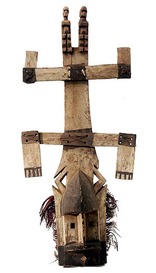
Dogon Tribe - Mali
The most known Dogon mask is the kanaga mask which represents the bird with the same name. The triangular form of the face is the jaw of the bird and the lower conical form is its tongue. The mask is finished by a structure which represents the bird's spread wings. In most villages the mask's four wooden extremities point in opposing directions whereas, in some villages, they all point upwards. The two small pictures on the face represent their ancestors. The cross refers to the myth of creation. The upper part of the cross symbolizes the supernatural world, and the lower part symbolizes the terrestrial world. The line between the two parts is the union between the two worlds. In accordance with mythology, the cross of the mask is the God's hand. The dancers always appear in large numbers. The person wearing the mask bends down when he dances, pointing his cross at the ground with the intention to establish a link between earth and sky. For funeral rites, members of the Awa's society with masks dance on the house' roof of the dead man, in order to lead his soul (nyama) into its eternal rest, and in the same time in order to defend the living from harm he can do to them. The Kanaga mask is also used to protect the hunter from the revenge of the prey he killed.
The most known Dogon mask is the kanaga mask which represents the bird with the same name. The triangular form of the face is the jaw of the bird and the lower conical form is its tongue. The mask is finished by a structure which represents the bird's spread wings. In most villages the mask's four wooden extremities point in opposing directions whereas, in some villages, they all point upwards. The two small pictures on the face represent their ancestors. The cross refers to the myth of creation. The upper part of the cross symbolizes the supernatural world, and the lower part symbolizes the terrestrial world. The line between the two parts is the union between the two worlds. In accordance with mythology, the cross of the mask is the God's hand. The dancers always appear in large numbers. The person wearing the mask bends down when he dances, pointing his cross at the ground with the intention to establish a link between earth and sky. For funeral rites, members of the Awa's society with masks dance on the house' roof of the dead man, in order to lead his soul (nyama) into its eternal rest, and in the same time in order to defend the living from harm he can do to them. The Kanaga mask is also used to protect the hunter from the revenge of the prey he killed.
Mossi Tribe

Mossi Tribe - Burkina Faso
The Mossi make both political art and spiritual art. Figures are used by the ruling class to validate political power, and masks are used by the conquered peoples to control the forces of nature. Each year at the annual celebrations of the royal ancestors, figures of the deceased kings are displayed. On many occasions each year, especially during the long dry season from October to May, masks appear to honor the spirits of nature that control the forces of the environment The several mask styles reflect the diversity of the population before the 15th century invasion. Long tall masks in the north are made by the descendants of the conquered Dogon population, while red, white, and black animal masks in the southwest are made by descendants of the conquered Gurunsi peoples.
The descendants of the conquered farmers (nyonyose) honor nature spirits that provide them with supernatural power to control the weather, disease, crop failure, and general well-being. These are the "invented spirits" that become important as the congregation faces a particular affliction and which decrease in influence as the problem is solved. These spirits are often represented by masks and figures that make them visible and concrete. The spirits themselves provide, through the diviner, the religious laws that govern the community and so provide a system of sacred rule. The creator god Wennam is associated with the sun and with the political hierarchy (nakomse). The spiritual power of the nyonyose based on nature spirits is in direct opposition to the secular power of the nakomse based on the horse and associated with the sun. Among the most important religious celebrations are annual sacrifices to honor the memories of the royal ancestors, when each and every male head of a household reaffirms his dependence on the benevolence of the chief and his ancestors for health and well-being of his family.
The Mossi make both political art and spiritual art. Figures are used by the ruling class to validate political power, and masks are used by the conquered peoples to control the forces of nature. Each year at the annual celebrations of the royal ancestors, figures of the deceased kings are displayed. On many occasions each year, especially during the long dry season from October to May, masks appear to honor the spirits of nature that control the forces of the environment The several mask styles reflect the diversity of the population before the 15th century invasion. Long tall masks in the north are made by the descendants of the conquered Dogon population, while red, white, and black animal masks in the southwest are made by descendants of the conquered Gurunsi peoples.
The descendants of the conquered farmers (nyonyose) honor nature spirits that provide them with supernatural power to control the weather, disease, crop failure, and general well-being. These are the "invented spirits" that become important as the congregation faces a particular affliction and which decrease in influence as the problem is solved. These spirits are often represented by masks and figures that make them visible and concrete. The spirits themselves provide, through the diviner, the religious laws that govern the community and so provide a system of sacred rule. The creator god Wennam is associated with the sun and with the political hierarchy (nakomse). The spiritual power of the nyonyose based on nature spirits is in direct opposition to the secular power of the nakomse based on the horse and associated with the sun. Among the most important religious celebrations are annual sacrifices to honor the memories of the royal ancestors, when each and every male head of a household reaffirms his dependence on the benevolence of the chief and his ancestors for health and well-being of his family.
Okuji Face Mask
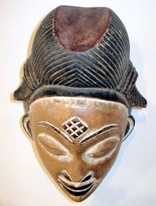
Punu Tribe - Ivory Coast
The Face Mask (Okuji) is painted in white and blackish brown and represent the spirits of female ancestors. The white color of the mask is genderless; white is a symbol for peace, deities, spirits of the dead, and the afterlife. These masks are worn by Mukuji initiates and could be worn during mourning but also at birth ceremonies and, therefore, symbolize a link with loved ones both already dead and those just born. The masks are used during the “mukuji”dance by dancers on high stilts dressed in skins and raffia cloths with a colorful costume covering her body. Known in different names, Okuji, duma or mvudi, it represents a female guardian spirit in the initiation of young girls, funerary rites, ancestor cults, and also in dances of the full moon. They claimed to have the power of the spirit of the mask they were wearing and it was the mask that enabled them to perform this spectacular dance admired by all. Social cohesion is ensured by the Mukuji society, whose primary role is to subjugate harmful forest spirits. The white pigments on masks allude to the anti-witchcraft powers of this group.
The refined features and elaborated coiffure of the Puno masks mirror the appearance of tribal women and represents the Punu ideals of feminine beauty; beautiful narrow, oval face, delicate chin, protruding lips and highly arched eyebrows above the almond shaped eyes. Unusual, elaborate, rigid and very elegant coiffure resembles the hairdo of the women living in this region. It has scarification patterns of 9 dots arranged in a square or diamond on the forehead.
The Face Mask (Okuji) is painted in white and blackish brown and represent the spirits of female ancestors. The white color of the mask is genderless; white is a symbol for peace, deities, spirits of the dead, and the afterlife. These masks are worn by Mukuji initiates and could be worn during mourning but also at birth ceremonies and, therefore, symbolize a link with loved ones both already dead and those just born. The masks are used during the “mukuji”dance by dancers on high stilts dressed in skins and raffia cloths with a colorful costume covering her body. Known in different names, Okuji, duma or mvudi, it represents a female guardian spirit in the initiation of young girls, funerary rites, ancestor cults, and also in dances of the full moon. They claimed to have the power of the spirit of the mask they were wearing and it was the mask that enabled them to perform this spectacular dance admired by all. Social cohesion is ensured by the Mukuji society, whose primary role is to subjugate harmful forest spirits. The white pigments on masks allude to the anti-witchcraft powers of this group.
The refined features and elaborated coiffure of the Puno masks mirror the appearance of tribal women and represents the Punu ideals of feminine beauty; beautiful narrow, oval face, delicate chin, protruding lips and highly arched eyebrows above the almond shaped eyes. Unusual, elaborate, rigid and very elegant coiffure resembles the hairdo of the women living in this region. It has scarification patterns of 9 dots arranged in a square or diamond on the forehead.
Kpelie Mask
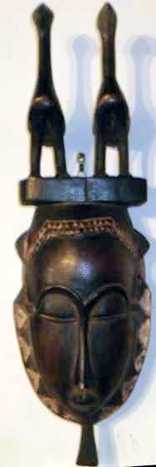
Senufu Tribe - Ivory Coast
The Senufu tribe uses several types of masks depending upon the occasion. The kpelie, a human face with projections all around, is said to remind initiates of human imperfection. Danced by men, these masks perform as female characters. Animal-head masks usually combine characteristics of several creatures--hyena, warthog, and antelope. A type of animal mask called waniugo has a cup for a magical substance on top; these masks blow sparks from their muzzles in a nighttime ritual protecting the village from sorcerers. Among the Naffara group of the Senufo, masks of similar form but with an interior cavity too small for a human head are carried on the top corner of a rectangular, tent like costume called kagba. This mask is the symbol of the Lo, which only initiates may see. In the Korhogo region, deguele masks appear in pairs at funerals. They are of plain helmet shapes topped with figures whose bodies are carved to resemble a pile of rings.
The Senufu tribe uses several types of masks depending upon the occasion. The kpelie, a human face with projections all around, is said to remind initiates of human imperfection. Danced by men, these masks perform as female characters. Animal-head masks usually combine characteristics of several creatures--hyena, warthog, and antelope. A type of animal mask called waniugo has a cup for a magical substance on top; these masks blow sparks from their muzzles in a nighttime ritual protecting the village from sorcerers. Among the Naffara group of the Senufo, masks of similar form but with an interior cavity too small for a human head are carried on the top corner of a rectangular, tent like costume called kagba. This mask is the symbol of the Lo, which only initiates may see. In the Korhogo region, deguele masks appear in pairs at funerals. They are of plain helmet shapes topped with figures whose bodies are carved to resemble a pile of rings.
Kifwebe Mask
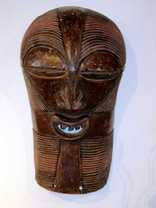
Songye Tribe - DRC
The Songye, are a people of the Democratic Republic of Congo, formerly known as Zaire, and before that, the Belgian Congo. The Kifwebe tradition which exists also among the Luba, seems to have originated south of the eastern chiefdom in an area of Luba/Songe. The Kifwebe mask is made for the Bwadi Bwa Kifwebe Secret society. "Kifwebe" means "Mask" in the Songye language and represents spirits of the ancestors during initiation ceremonies. The face generally is covered with linear incisions which are sometimes pigmented, the mouth is most often square and protruding. The size of the crest determines the magical power of the mask. These masks are kept in special huts and are brought out and danced primarily during the funerals of important individuals of the society.
Three mask types exist: two male and one female. Male masks are distinguished by a striated pattern of three colors while the female is predominantly white with the features accented in black and some in red. It is believed that three spirits, two male and one female emerged from the lake. The gentle female spirit found its way into the village and liked it there and was compatible with human beings. She is soothing, aids in fertility matters and intercedes in the female and matrilineal powers of the supernatural. The male spirits emerged from the lake. It is less benign and more severe and more unpredictable than the female, dancing in spectacular fashion. It is also a regulator of supernatural powers of a more masculine form. It is also capable of inflicting punishment and enforcing societal rules.
The Songye, are a people of the Democratic Republic of Congo, formerly known as Zaire, and before that, the Belgian Congo. The Kifwebe tradition which exists also among the Luba, seems to have originated south of the eastern chiefdom in an area of Luba/Songe. The Kifwebe mask is made for the Bwadi Bwa Kifwebe Secret society. "Kifwebe" means "Mask" in the Songye language and represents spirits of the ancestors during initiation ceremonies. The face generally is covered with linear incisions which are sometimes pigmented, the mouth is most often square and protruding. The size of the crest determines the magical power of the mask. These masks are kept in special huts and are brought out and danced primarily during the funerals of important individuals of the society.
Three mask types exist: two male and one female. Male masks are distinguished by a striated pattern of three colors while the female is predominantly white with the features accented in black and some in red. It is believed that three spirits, two male and one female emerged from the lake. The gentle female spirit found its way into the village and liked it there and was compatible with human beings. She is soothing, aids in fertility matters and intercedes in the female and matrilineal powers of the supernatural. The male spirits emerged from the lake. It is less benign and more severe and more unpredictable than the female, dancing in spectacular fashion. It is also a regulator of supernatural powers of a more masculine form. It is also capable of inflicting punishment and enforcing societal rules.
War Mask
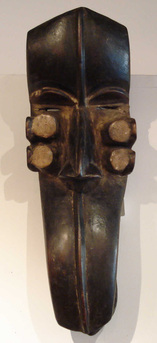
Grebo Tribe - Liberia
The Grebo inhabit the coastal region of eastern Liberia and the bordering forestlands. They are ruled by a chief known as Bodio who lives in near total isolation and also assumed the function of grand priest. The Grebo masks incarnate the spirits of the invisible wolrd who live in the foreest. Unlike the other people living in Liberia, the Grebo are not structured by the Poro society. A characteristic trait of Grebo masks is polychrome painting. The successful raids, and similiar military masquerades inspired them to fight. Symboloizing the implacable nature of battle, this war mask is designed primarily to terrify. These masks appeared also during the funerals of warriors. The tubular projections represent several sets of extra eyes.
The Grebo inhabit the coastal region of eastern Liberia and the bordering forestlands. They are ruled by a chief known as Bodio who lives in near total isolation and also assumed the function of grand priest. The Grebo masks incarnate the spirits of the invisible wolrd who live in the foreest. Unlike the other people living in Liberia, the Grebo are not structured by the Poro society. A characteristic trait of Grebo masks is polychrome painting. The successful raids, and similiar military masquerades inspired them to fight. Symboloizing the implacable nature of battle, this war mask is designed primarily to terrify. These masks appeared also during the funerals of warriors. The tubular projections represent several sets of extra eyes.
Yatenga Mask

Mossi Tribe - Burkina Faso
In the Savanna Region of West Africa (Burkina Faso), the Mossi tribe pay tribute to deceased elders using a "Yatenga" mask. This mask honors a woman's age, wisdom, and experience. Used in dance, it elevates her to the rank of a living ancestress, intermediary between the living and the spirits of the family's ancestors.
In the Savanna Region of West Africa (Burkina Faso), the Mossi tribe pay tribute to deceased elders using a "Yatenga" mask. This mask honors a woman's age, wisdom, and experience. Used in dance, it elevates her to the rank of a living ancestress, intermediary between the living and the spirits of the family's ancestors.
Yaure Tribe
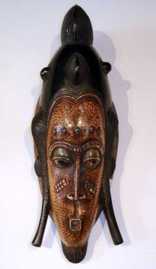
Yaure Tribe - Ivory Coast
The Yaure are a sub-tribe of the Baule. The masks of the Yaure represent human faces often supplemented by animal attributes. They have an elongated face with a protruding mouth and pierced semi-circular eyes set under a high forehead. An elaborate plaited coiffure parted on each side, often with horns at the end, completes the image, while the outline of the mask is characteristically surrounded by a serrated edge. The masks are considered emblems of "yu" spirits. Cases of death that jeopardize the social order are the principal occasions for an appearance of masqueraders. By means of their dance, they restore the social equilibrium of the community and accompany the deceased into the ancestral realm. These masks are worn predominantly on two occasions: the "je" celebration and the "lo" ceremony. The first purifies the village after a death and helps the deceased's soul on its way to a final resting place. Painted masks are mainly worn by dancers during this ceremony, while for the "lo" funeral ceremony, masks covered with black pigments will be worn. Women may not participate in funeral ceremonies, neither may they look at the masks, for fear that this encounter with death might jeopardize their fecundity. This means that before starting the village’s purification rituals related to a death, for prudence sake the women are gotten out of the way. With the aid of such masks, the people hope to influence supernatural powers, or "yu" spirits, that can do harm to humans, but that can also ensure their welfare. The function of each type of mask is not rigidly fixed, which leads to their appearance during either ceremony.
The Yaure are a sub-tribe of the Baule. The masks of the Yaure represent human faces often supplemented by animal attributes. They have an elongated face with a protruding mouth and pierced semi-circular eyes set under a high forehead. An elaborate plaited coiffure parted on each side, often with horns at the end, completes the image, while the outline of the mask is characteristically surrounded by a serrated edge. The masks are considered emblems of "yu" spirits. Cases of death that jeopardize the social order are the principal occasions for an appearance of masqueraders. By means of their dance, they restore the social equilibrium of the community and accompany the deceased into the ancestral realm. These masks are worn predominantly on two occasions: the "je" celebration and the "lo" ceremony. The first purifies the village after a death and helps the deceased's soul on its way to a final resting place. Painted masks are mainly worn by dancers during this ceremony, while for the "lo" funeral ceremony, masks covered with black pigments will be worn. Women may not participate in funeral ceremonies, neither may they look at the masks, for fear that this encounter with death might jeopardize their fecundity. This means that before starting the village’s purification rituals related to a death, for prudence sake the women are gotten out of the way. With the aid of such masks, the people hope to influence supernatural powers, or "yu" spirits, that can do harm to humans, but that can also ensure their welfare. The function of each type of mask is not rigidly fixed, which leads to their appearance during either ceremony.
Kple Kple Mask
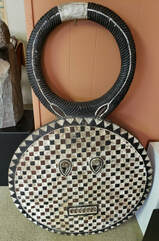
Baule Tribe - Ivory Coast
This Kple Kple mask is representative of a second group of Baule masks. The face of this Baule Goli mask is flat, the eyes have and oval shape and the mouth is rectangular, the mask also has two horns from the top of the head that represent power and strength. The round head is said to stand for the sun, and the horns for the buffalo. The Goli is used as a symbol of fertility during agricultural and commemorative ceremonies andi is also paraded during the occasions of a new harvest, the visit of dignitaries, or at the funerals of notables. The mask wearer mediates with supernatural forces during the ritual, which have a positive influence on the village people. These rituals appear 3 times during the day: dawn, afternoon and after sunset. The dance announces the arrival of Goli Glin a zoomorphic figure or of kpwan. The Baule tribe adopted this ritual from the neighboring Wan tribe, even the language of the Wan is still use during the ritual.
This Kple Kple mask is representative of a second group of Baule masks. The face of this Baule Goli mask is flat, the eyes have and oval shape and the mouth is rectangular, the mask also has two horns from the top of the head that represent power and strength. The round head is said to stand for the sun, and the horns for the buffalo. The Goli is used as a symbol of fertility during agricultural and commemorative ceremonies andi is also paraded during the occasions of a new harvest, the visit of dignitaries, or at the funerals of notables. The mask wearer mediates with supernatural forces during the ritual, which have a positive influence on the village people. These rituals appear 3 times during the day: dawn, afternoon and after sunset. The dance announces the arrival of Goli Glin a zoomorphic figure or of kpwan. The Baule tribe adopted this ritual from the neighboring Wan tribe, even the language of the Wan is still use during the ritual.
Nimba Mask
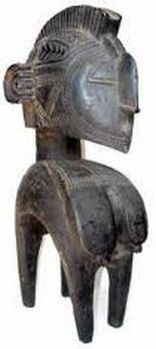
Baga Tribe - Guinea
This mask represents the goddess Nimba said to have served the Simo Society as symbols of fertility and protector of maternity She is invoked during the rice harvest. The monumental sculpture with its long flattened breast, the breast of a woman who has nourished many infants, suggest female power and seniority. The sculpture is worn over the head and rest on the shoulders of the dancer who usually sees through a slot between the breast. During performances, the massive headdress is worn with a costume of raffia and cloth. The Nimba ceremony was performed at least twice a year before the rainy seasons and would also appear at festive occasions such as marriages and funerals, and in honor of special guests.
Unlike masked representations from other African cultures, which may represent ethereal spirits or ancestors, Nimba is not a "spirit," but instead is loosely described by the Baga themselves as simply an "idea." Nimba is an abstract ideal of the female role in Baga society. She is honored as the universal mother and is the vision of woman at the zenith of her power, beauty, and affective presence. Although Nimba is not a spiritual being in the Baga sense of the term, nor a deity, she is a being of undeniable spiritual power. The Baga conceive of Nimba as a servant of sorts—inspiring young women with the strength to bear children and raise them to adulthood, inspiring young men to cooperative excellence in agriculture, and inspiring the ancestors to contribute toward the continuance of community well-being.
This mask represents the goddess Nimba said to have served the Simo Society as symbols of fertility and protector of maternity She is invoked during the rice harvest. The monumental sculpture with its long flattened breast, the breast of a woman who has nourished many infants, suggest female power and seniority. The sculpture is worn over the head and rest on the shoulders of the dancer who usually sees through a slot between the breast. During performances, the massive headdress is worn with a costume of raffia and cloth. The Nimba ceremony was performed at least twice a year before the rainy seasons and would also appear at festive occasions such as marriages and funerals, and in honor of special guests.
Unlike masked representations from other African cultures, which may represent ethereal spirits or ancestors, Nimba is not a "spirit," but instead is loosely described by the Baga themselves as simply an "idea." Nimba is an abstract ideal of the female role in Baga society. She is honored as the universal mother and is the vision of woman at the zenith of her power, beauty, and affective presence. Although Nimba is not a spiritual being in the Baga sense of the term, nor a deity, she is a being of undeniable spiritual power. The Baga conceive of Nimba as a servant of sorts—inspiring young women with the strength to bear children and raise them to adulthood, inspiring young men to cooperative excellence in agriculture, and inspiring the ancestors to contribute toward the continuance of community well-being.
